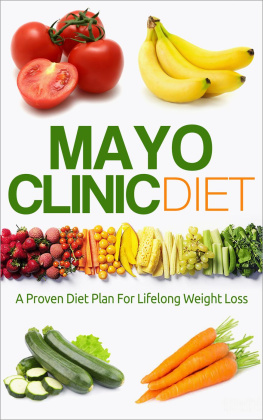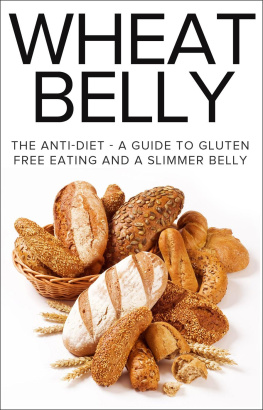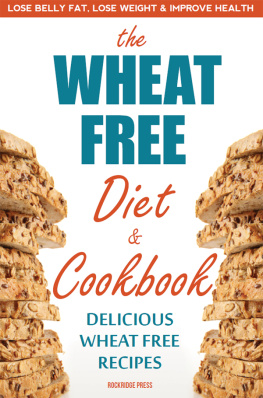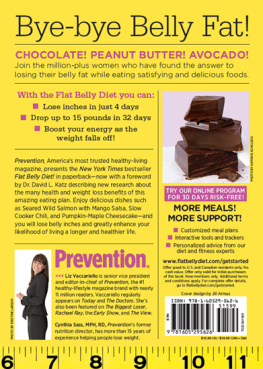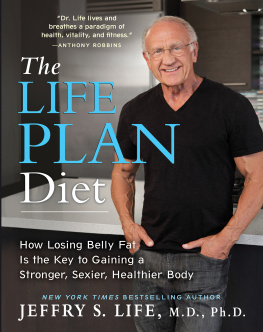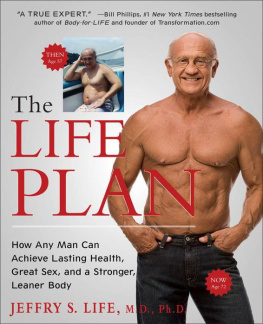More from the Author |
| |
Mastering the Life Plan | The Life Plan |
Acknowledgments
This book would not have been possible without the love and support of my wife, Annie. I consider myself incredibly fortunate that she entered my life when she did, and she continues to provide me with the incentives I need to achieve optimal health. Im especially thankful for all of the great recipes she has provided for my books.
I would also like to thank my agent, Carol Mann, and all the folks at Atria Books. Sarah Durand and Judith Curr support my vision, and their entire team has been tremendous to work with.
My writer, Pam Liflander, continues to help me get my thoughts and beliefs on paper, and then organize and craft all of them into words that perfectly describe what men need to know to stay healthy, lose weight, and avoid feeling old.
Id like to thank Joey Carson for all of his support and friendship. Dr. Phil McGraw and his son, Jay, have been huge supporters of my mission. Lauren Tancredi helps keep me organized and on track. Mike Starks, founder and CEO of Personal Trainer Food, has played an important new role in my understanding of the fasting aspect of this new program. Jason Ellis, my photographer, has done an outstanding job helping me look my best on this new book cover.
Amy Doneen, MSN, ARNP, and Brad Bale, MD, creators of the Bale/Doneen Method for preventing heart attacks and strokes, continue to assist with my own heart health as well as the health of my patients. I would also like to thank my friends at Cenegenics for supporting my mission to improve mens health everywhere.
I would like to thank Dr. Max Sawaf, founder of Wellness Wave, for his encouragement and friendship. I am so impressed with his team that I have moved my medical practice to Wellness Wave in Beverly Hills.
Finally, none of this would have been possible if it werent for the pioneering work of the late Alan P. Mintz, MD, the Father of Age Management Medicine. We all miss him very much.
Also by Jeffry S. Life, MD, PhD
Mastering the Life Plan
The Life Plan
APPENDIX
The Life Plan Diet Food Journal
Y ou now have all the information you need to master the Life Plan Diet. The rest is up to you. Can you motivate yourself off the couch and into the gym? Can you find the time in even the busiest days to make change happen? For me, once I started there was no going back. I made a commitment to myself and Im proud to say that 16 years later I still feel better every year than the year before. So for me, the choice is obvious. As Im sure it will be for you.
Im much better at sticking to a diet and exercise program if I write down every day exactly what Ive accomplished. This works for me on several levels. First, it makes me accountable for everything that I put into my mouth. I then have a record to refer to so that I can track my success and be able to see why some weeks were more effective than others. Tracking my progress also provides a sense of satisfaction at the end of each day when I recognize that I was able to stay on track.
You can photocopy these pages or download them from my website, www.drlife.com. Put a weeks worth of sheets in a binder or fold them in your wallet, and bring them with you wherever you go. You can also keep this information on your smartphone or iPad. I like to fill in the information as I go throughout the day, instead of trying to remember before bedtime what I ate or which exercises I performed. And by recording my meals right after I eat them, I can see if I need to make small adjustments later on in the day. For example, if I had to eat breakfast out of the house, and the omelet I ordered at the restaurant was made with three eggs instead of two, I can choose a lower-calorie snack during the day to compensate.
Its crucial to stick with this program for the full twelve weeks. It generally takes that long just for your brain to create new habits and your body to get into the swing of clean eating. By then you will see significant changes to your physique.
The Life Plan Food Journal
After each meal, write down exactly what you ate. Also include the time that you ate and your level of hunger 20 minutes after eating, ranking it on a scale from 1 to 10. This is a good way of tracking your satiety, which can assist you in learning how to eat based upon hunger and timing rather than habit. Record how much water you drank during and previous to each meal so that you can add the amounts to see if you are meeting your goal. Finally, you can also check off if you took your supplements each day, and list weekly which ones you are taking.
Week # | Monday | Tuesday | Wednesday | Thursday | Friday | Saturday | Sunday |
MEAL #1 Type: Time: Hunger level: oz of water: |
MEAL #2 Type: Time: Hunger level: oz of water: |
MEAL #3 Type: Time: Hunger level: oz of water: |
MEAL #4 Type: Time: Hunger level: oz of water: |
MEAL #5 Type: Time: Hunger level: oz of water: |
MEAL #6 Type: Time: Hunger level: oz of water: |
Supplements taken: |
After you have kept your workout and nutrition logs for a few weeks you can begin to analyze the information you have gathered. Try to be very objective when reading your logs and ask yourself the following questions:
Am I progressing? Am I losing weight and generally feeling better about the way I look and feel?
Are my clothes fitting differently? Is my waistline decreasing?
Am I tired after exercise? Am I working at my highest capability?
Am I taking my supplements? Am I skipping days, or maintaining consistency?
Am I sleeping better at night? Do I feel rested when I wake up in the morning, and do I go to sleep easily at night? Do I feel energized throughout the day, or sluggish?
Am I eating the right amount of balanced meals? Am I on track to reach my goals?
Am I drinking enough water?
JEFFRY LIFE, M.D., Ph.D., is the bestselling author of The Life Plan and Mastering the Life Plan . At a vibrant seventy-five years old, he is in great shape, still practicing medicine, and at the top of the healthy-aging field. In 2012, Mens Fitness magazine chose him as one of the top 25 fittest men in the world. He has been featured in The New York Times, The Los Angeles Times , and Esquire magazine, as well as on national TV shows, including The Doctors, Steve Harvey , and The Dr. Phil Show. He is the medical director of the Wellness Wave Medical Center in Beverly Hills, California. His website is DrLife.com.
MEET THE AUTHORS, WATCH VIDEOS AND MORE AT
SimonandSchuster.com
authors.simonandschuster.com/Jeffry-S-Life
Facebook.com/AtriaBooks
@AtriaBooks
CHAPTER 1
Age Management through Waist Management
T he one area of the body that disappoints most men, especially as they get older, is their stomach. Abdominal or visceral obesitywhat we often refer to as the pot belly or beer gutis such a common occurrence that most men think of their expanding waistline as a rite of passage or a normal part of aging that cant be changed. This is, in fact, partially true: As men get older, they are at much greater risk for developing belly fat. But let me tell you, adjusting your belt a notch every few years is not normal, and its the one part of your body that can eventually do you more harm than good. Thats why this book focuses almost exclusively on lightening the load thats resting at your belly.


